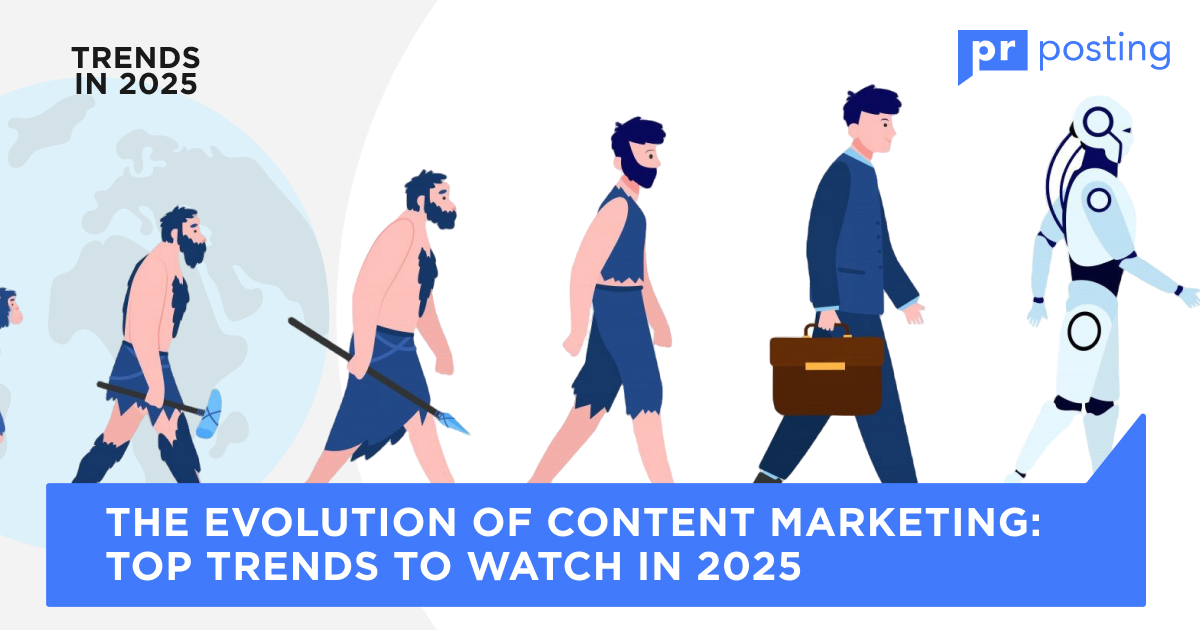The Evolution of Content Marketing: Top Trends to Watch in 2025

The mix of automation, short media, and storytelling will reshape the digital landscape. Success depends on adaptability — those who embrace change will thrive, while others risk being left in the shadows. So, what defines the strategies of tomorrow? A focus on interactivity, authenticity, and data-driven personalization is leading the way. This article explores the most prominent trends, highlighting how the best AI tools for marketing optimize content creation, personalization, and community engagement.
The digital world moves fast, and content strategies change just as quickly. To remain competitive, it is necessary to embrace forward-looking trends. In 2025, content marketing will rely on perfect targeting and dynamic experiences. Anticipating these shifts allows marketers to craft impressive campaigns that resonate.
AI and Automation are Changing Content Marketing
Use AI Tools and Automation
AI technology revolutionizes marketing operations. Automated tools streamline routine tasks and enhance creativity.
Consider the following examples:
- Content generation. Tools like Jasper and Copy.ai craft engaging content quickly.
- Scheduling and distribution. Platforms like Buffer optimize posting schedules.
- Performance tracking. Systems like HubSpot analyze engagement metrics in real time.
Automating these areas saves time and boosts consistency across channels.
AI-Driven Personalization
Hyper-personalized marketing is no longer a luxury — it’s essential. AI algorithms analyze consumer behavior to predict preferences, which has the prophetic power to create customized content.
Examples include:
- Netflix recommends personalized shows based on one-time viewing.
- Amazon suggests products that match your recent purchases.
These systems increase engagement by delivering relevant and timely content. Brands that use AI automation services to personalize relationships gain a competitive advantage.
Engaging Content Trends in 2025
Personal and Conversational Content
Consumers demand engagement. Conversational content makes brands feel approachable and helps establish a special connection. Instead of broadcasting a message, create a dialogue. Be clear.
Here’s how to get started:
- Use natural language. Avoid corporate jargon.
- Ask for feedback. Engage your audience with questions.
- Tailor your message. Make each communication feel personalized.
By crafting conversational content, you can make your brand more natural. This connection boosts loyalty, and consumers feel valued rather than targeted.
Storytelling
Why is storytelling important? It goes beyond information to create emotional connections. Narratives inspire action and make messages memorable.
Consider these storytelling strategies:
- Focus on life experiences to evoke empathy.
- Use conflict resolution structures to keep things interesting.
- Highlight transformational pathways to inspire engagement.
Why is storytelling important? Storytelling infuses marketing with purpose, which leads to more profound brand affinity.
Evergreen Content with a Fresh Twist
Rethink dateless topics to maximize the lifespan of your content. Evergreen content examples include how-to guides, resource lists, and key industry insights.
Evergreen Content Examples
Some content never gets old. Evergreen content examples remain applicable for a long time. Still, they require periodic updates to preserve value.
Some examples include:
- How-to guides. Always helpful and searchable.
- Resource lists. Valuable for newcomers in your industry.
- Industry insights. Keep you up-to-date with new trends.
To make your evergreen content effective, consider these steps:
- Update data and statistics. Keep data relevant.
- Integrate multimedia. Visuals, infographics, and videos enhance engagement.
- Optimize for SEO. Refresh keywords and internal links to improve visibility.
These simple steps can extend the life of your content.
Short form Video
Short-form video is dominating digital platforms. It’s fast, engaging, and direct; people consume content rapidly. Platforms like TikTok, YouTube Shorts, and Instagram Reels meet this need and have changed the way we create and share content.
To make the most of short-form video, follow these steps:
- Hook customers right away. Grab attention in the first 3 seconds.
- Keep videos short. Limit the duration to keep things interesting.
- Add captions. Many viewers watch videos without sound.
- Prioritize authenticity. Show the real side of your brand.
These videos create quick emotional connections. They are easy to share and remember.
Augmented Reality Marketing
Augmented reality (AR) marketing offers new ways to engage consumers. It enhances the user experience by blending digital elements with the real world. AR allows consumers to interact with products before buying. This creates a deeper connection and allows you to make more informed purchasing decisions.
Here is why AR is precious:
- Enhanced product visualization. See how products fit into your environment.
- Immersive experiences. Attract customers with unique interactive content.
- Increased purchase confidence. Help consumers feel confident in their choices.
Integrating augmented reality marketing into your strategy will result in increased engagement and conversions.
To succeed in 2025, prioritize engagement. Use conversational content to build genuine relationships. Utilizeshort-form videos to grab attention quickly. Refresh evergreen content examples to keep them relevant. Invest in augmented reality marketing to offer interactive, immersive experiences. These strategies will help your brand grow in the evolving digital space.
Community and User-Generated Content
Building an Engaged Community
Creating a loyal following requires thoughtful engagement. Invite users to share meaningfully and encourage interaction through customized responses and relevant dialogues.
Consider these strategies:
- Host live broadcasts to foster real-time engagement.
- Use polls and surveys to gather user opinions.
- Reward contributions with recognition or exclusive content.
Engaged communities transform reluctant audiences into active brand followers.
User Generated Content
User-generated content builds trust. Authentic brand advocacy strengthens trust and expands reach.
Examples of user-generated content include:
- Customer reviews and testimonials;
- Photos on social media with branded products;
- Video unboxings and tutorials.
Highlight user stories to reinforce authentic connections and social proof.
Optimizing for Search and Discovery
Voice Search Optimization
Voice search optimization in digital marketing ensures content that reaches voice queries. Speech is different from typed searches.
Focus on these tactics:
- Use conversational phrases in your headings and copy.
- Target keywords based on questions (“how to” and” what is”).
- Optimize for original intent with location-specific terms.
Voice search optimization in digital marketing is shaping the way users find information. Businesses can better position their content for voice interfaces by implementing structured data and natural language patterns. Voice assistants prioritize brief, clear responses. To increase relevancy, include featured particles and “People Also Ask” phrases. Adapting to voice search trends enhances discoverability and accessibility for broader audiences.
Niche Content Marketing
Niche content marketing prioritizes depth over breadth. Specialized content meets precise audience needs. To succeed:
- Identify underserved or emerging markets;
- Develop unique, expert-level resources;
- Tailor messaging to align with niche interests.
Targeted strategies build authority and drive loyal traffic. For example, focusing on highly specialized topics creates content that resonates deeply with niche audiences.
Content about unique industry solutions or local market insights attracts specific, motivated readers. Unlike generalized content, niche marketing fosters a community of highly engaged users. Providing continuous value strengthens your influence within your chosen area of expertise.
Generative Engine Optimization (GEO)
Generative engine optimization (GEO) adapts content for AI-driven search, boosting visibility in dynamic search engines like ChatGPT and Google AI.
Key techniques include:
- Structuring content for concise, relevant answers;
- Using semantic keywords and natural language patterns;
- Updating content frequently to match AI learning patterns.
GEO enhances search performance by aligning with evolving algorithms. It bridges the gap between human-centric content and machine-learning models. To optimize for GEO, ensure clarity and directness. Answer queries clearly while providing depth where needed. Integrating question-based subheadings improves scannability for AI summaries.
With algorithms increasingly interpreting intent, conversational tone and contextually rich content improve relevance. Incorporate cross-referenced links to reinforce topical authority. GEO-ready content positions your brand for AI visibility and expands reach as search technologies evolve.
Data-Driven Content Strategies
In 2025, successful content strategies will count on blending human creativity with data analysis. Purpose driven content, based on authentic storytelling and responsible practices, will continue to resonate with audiences.
However, utilizing third-party data and the latest AI tools to optimize your marketing efforts is equally important. This article explores these crucial trends and offers strategies to succeed.
Focusing on Third-Party Data
The digital terrain is changing, especially with the decline of cookies. Depending solely on first-party data is no longer enough. Marketers must look to third-party data to fill the gaps. These external sources deliver rich information about consumer behavior, preferences, and trends.
How to use third-party data
- Partner with respectable data providers;
- Use analytics to upgrade client segments;
- Optimize content for more precise targeting.
Integrating third-party data ensures you stay relevant in a cookie-less world.
Purpose Driven Content
As consumers become more mindful of the brands they support, targeted content has become an important marketing tool. Audiences expect transparency and want to know what a brand stands for. Content that emphasizes authenticity, sustainability, and social responsibility drives deeper connections with customers.
To produce purpose-driven content:
- Center on showcasing brand values through storytelling with a particular focus on sustainability efforts and ethical standards.
- Create content that will deliver social impact.
Purpose driven content helps build trust and loyalty, making your brand more recognizable.
Human and AI Collaboration
The best-performing content in 2025 will be a result of human and AI collaboration. While AI tools are powerful for simplifying processes, human creativity is irreplaceable. Combining the strengths of both leads to more attractive and efficient content.
How to balance AI with human creativity:
- Use AI tools for data analysis and spot trends.
- Use AI to automate content, similar to writing templates.
- Let humans drive the emotional and creative basics of content.
The best AI tools for marketing will help you implement your strategy. However, human understanding is crucial for content that truly connects with followership. By blending the efforts of AI and humans, you can create content that resonates, performs, and drives outcomes.
Multi-platform Strategies
In 2025, content marketing will demand flexibility and precision. Brands must expand their content strategies to reach different followers. Applying multichannel marketing strategies will be crucial to achieving visibility.
Content must be engaging and applicable across all platforms.
This includes utilizing the latest AI automation services and creating conversational content that resonates on a personal level. Also, niche content marketing will continue to thrive as audiences demand more customized experiences. Staying ahead of industry changes, your content will remain relevant in the fast-evolving digital space.
Expanding the reach of your content across multiple platforms is essential in 2025. Audiences are no longer limited to one channel. Brands must meet consumers where they are, whether on social media, podcasts, or video platforms. A unified but flexible approach ensures that content is optimized for each platform.
How to succeed with multichannel marketing strategies:
- Understand the nuances of the platform. Adapt content for each platform (Instagram, LinkedIn, YouTube, etc.).
- Optimize visuals and formats. Make sure your content adapts to different screen sizes and formats.
- Reuse your content. Convert articles into infographics, videos, or social posts to maximize reach.
- Track the performance across all channels. Analyze metrics to refine strategies for better engagement.
Maximizing your presence across platforms increases audience engagement and brand recall.
Conclusion
To thrive in 2025, your content marketing strategies must be dynamic and forward-thinking.
Here are the main strategies:
- Use multichannel marketing strategies. Reach your audience where they spend their time.
- Use AI automation services. Use AI to enhance efficiency, personalization, and targeting.
- Focus on conversational content. Speak directly to your followership in an approachable manner.
- Experiment with augmented reality marketing. Engage users with immersive experiences.
- Create specific, niche content. Adapt your communications to specific segments for deeper connections.
By proactively following these trends, your content will stay relevant and impactful. Stay ahead of the curve and set up your brand for long-term success in 2025 and beyond.
FAQs
How to write conversational content?
Use simple language, ask questions, and make it interesting. Conversational content helps build a connection.
What is the opposite of evergreen content?
Timely or trend-based content. Unlike examples of evergreen content, it loses relevance quickly.
What is personal content?
Personal content reflects individual stories, experiences, or opinions to evoke emotional resonance.
What is digital storytelling?
It is the art of preparing stories using digital formats. Why is storytelling important? The answer lies in building stronger connections with your audience.
Why is user-generated content so important?
It builds authenticity and trust. People trust people more than brands.
Why is short-form video so popular?
They are fast, interesting, and effective. Short-form videos grab attention and help to retain it.
What is purpose driven content marketing?
Content that aligns with brand values and social impact. Purpose-driven content builds trust and loyalty.
How to do voice search optimization?
Use natural language and question-based keywords. Voice search optimization in digital marketing improves search rankings.
What is generative engine optimization?
Generative engine optimization (GEO) combines AI tools to optimize and produce customized content.
How is augmented reality used in businesses?
Augmented reality marketing enhances product visualization, interactive ads, and immersive experiences.
Why have many companies begun employing multichannel marketing strategies?
Multichannel marketing strategies amplify reach by engaging audiences across multiple platforms.




